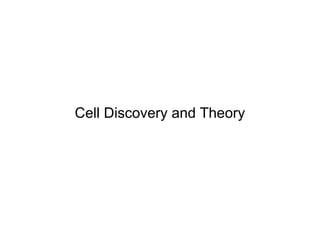Chapter 7 1
•Download as PPT, PDF•
0 likes•1,575 views
The document summarizes the history and development of the cell theory from early microscope observations of cells in the 1600s to the modern principles of the cell theory established in the 1800s. It describes the key scientists who contributed to cell discoveries and theory, including Hooke, van Leeuwenhoek, Schleiden, Schwann, and Virchow. The cell theory states that all living things are made of cells, cells are the basic units of structure and organization, and new cells are produced from existing cells. The document also provides a brief overview of microscope technology and the basic differences between eukaryotic and prokaryotic cells.
Report
Share
Report
Share

Recommended
More Related Content
What's hot
What's hot (20)
The Nobel Prize in Medicine 2013, Bui Dac Chi, Medic Center, Vietnam

The Nobel Prize in Medicine 2013, Bui Dac Chi, Medic Center, Vietnam
Similar to Chapter 7 1
Similar to Chapter 7 1 (20)
A. The development of the has allowed us to study cells and their pro.pdf

A. The development of the has allowed us to study cells and their pro.pdf
More from Valerie Evans
More from Valerie Evans (20)
Recently uploaded
Recently uploaded (20)
From Event to Action: Accelerate Your Decision Making with Real-Time Automation

From Event to Action: Accelerate Your Decision Making with Real-Time Automation
ProductAnonymous-April2024-WinProductDiscovery-MelissaKlemke

ProductAnonymous-April2024-WinProductDiscovery-MelissaKlemke
TrustArc Webinar - Stay Ahead of US State Data Privacy Law Developments

TrustArc Webinar - Stay Ahead of US State Data Privacy Law Developments
How to Troubleshoot Apps for the Modern Connected Worker

How to Troubleshoot Apps for the Modern Connected Worker
08448380779 Call Girls In Friends Colony Women Seeking Men

08448380779 Call Girls In Friends Colony Women Seeking Men
Mastering MySQL Database Architecture: Deep Dive into MySQL Shell and MySQL R...

Mastering MySQL Database Architecture: Deep Dive into MySQL Shell and MySQL R...
Handwritten Text Recognition for manuscripts and early printed texts

Handwritten Text Recognition for manuscripts and early printed texts
Scaling API-first – The story of a global engineering organization

Scaling API-first – The story of a global engineering organization
IAC 2024 - IA Fast Track to Search Focused AI Solutions

IAC 2024 - IA Fast Track to Search Focused AI Solutions
Bajaj Allianz Life Insurance Company - Insurer Innovation Award 2024

Bajaj Allianz Life Insurance Company - Insurer Innovation Award 2024
Tech Trends Report 2024 Future Today Institute.pdf

Tech Trends Report 2024 Future Today Institute.pdf
Raspberry Pi 5: Challenges and Solutions in Bringing up an OpenGL/Vulkan Driv...

Raspberry Pi 5: Challenges and Solutions in Bringing up an OpenGL/Vulkan Driv...
Powerful Google developer tools for immediate impact! (2023-24 C)

Powerful Google developer tools for immediate impact! (2023-24 C)
Presentation on how to chat with PDF using ChatGPT code interpreter

Presentation on how to chat with PDF using ChatGPT code interpreter
Chapter 7 1
- 1. Cell Discovery and Theory
- 2. History of the Cell Theory 1665- Robert Hooke- made a simple microscope and looked at a piece of cork. He saw small, box-shaped structures. He called them cellulae (Latin for small rooms). The term cell came from this word. Late 1600s- Anton van Leeuwenhoek, inspired by Hooke, designed his own microscope.
- 3. 1838- Matthias Schleiden- studied plant tissues and concluded that all plants are composed of cells. 1839- Theodor Schwann- reported that animal tissues also consist of individual cells. 1855- Rudolph Virchow- proposed that all cells are produced from the division of existing cells. The conclusions of these scientists and others are summarized as the cell theory.
- 4. Cell Theory includes 3 principles. 1. All living organisms are composed of one of more cells. 2. Cells are the basic unit of structure and organization of all living organisms. 3. Cells arise only from previously existing cells, with cells passing copies of their genetic material on to their daughter cells.
- 5. Microscope Technology Compound Light Microscope- consist of glass lenses each magnifies 10 times. The maximum magnifciation without blurring is 1000 X.
- 6. Electron Microscopes Transmission electron microscope (TEM)-uses magnets to aim a bean of electrons at thin slices of cells. Scanning electron microscope (SEM)- a modified electron microscope that directs electrons over the surface of the specimen, producing a 3D image.
- 7. Basic Cell Types Cell- basic structural and functional unit of all living organisms. Cells are grouped in 2 categories 1. Eukaryotic Cells- -eu prefix from Greek, meaning true -kary from Greek, meaning nucleus 2. Prokaryotic Cells -pro prefix from Greek, meaning before
- 9. Eukaryotic Cell Prokaryotic Cell Nucleus- a distinct central organelle that contains the cell's genetic material (DNA) Organelles-Specialized structures that carry out specific cell functions. Organisms that are made up of eukaryotic cells are called eukaryotes. Plasma Membrane- Special boundary that helps control what enters and leaves the cell. Has no nucleus or organelles. Organisms that are made up of prokaryotic cells are called prokaryotes. This includes most unicellular organisms like bacteria.